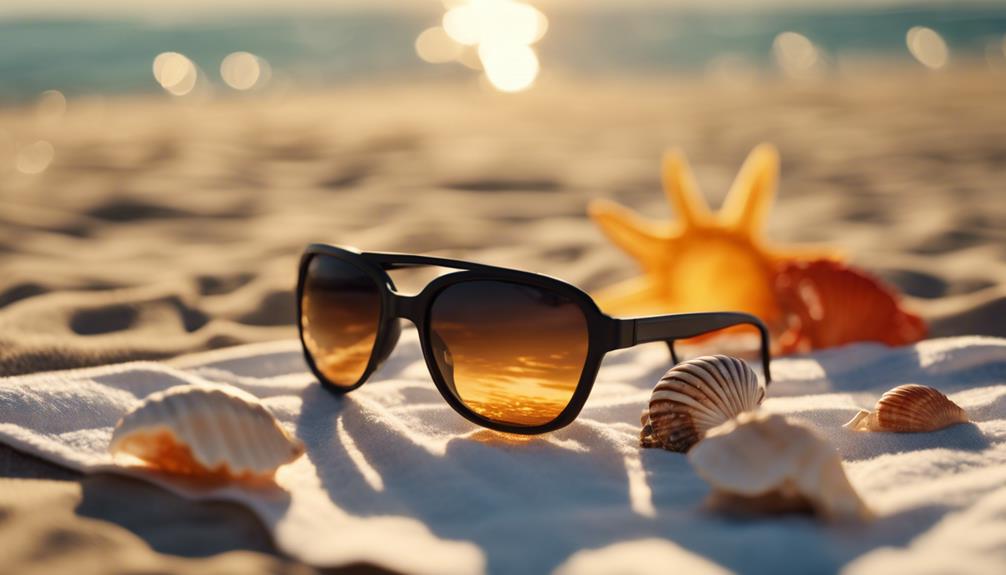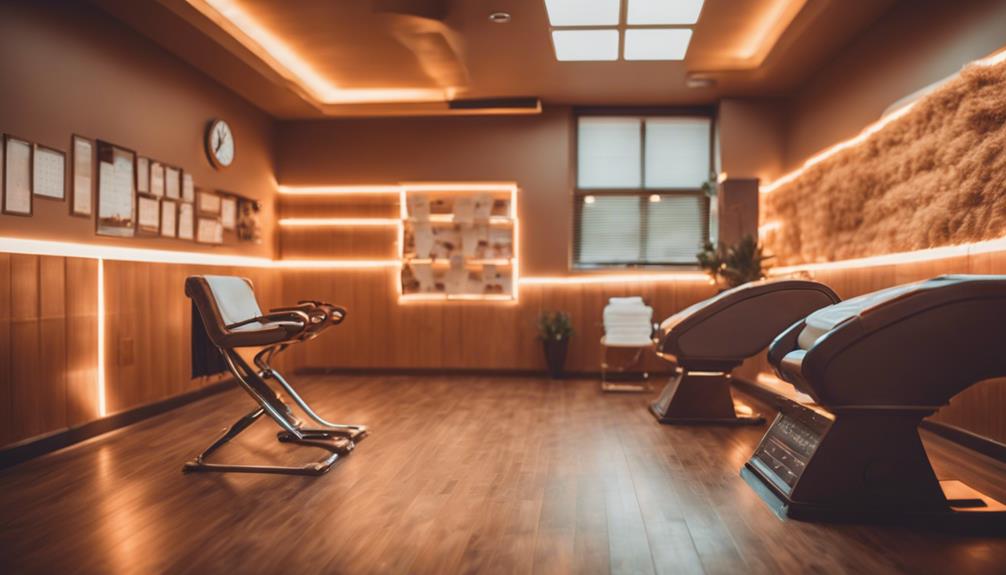Revealing the secrets to tanning bed success is easier than you think! First off, exfoliate your skin to ditch those dead cells. Then, go for a good tanning accelerator to help boost your glow. Start with short tanning sessions, gradually increasing time to avoid looking like a lobster! Keep your skin hydrated before and after, too — no one wants dry, flaky skin. Finally, don't rush the process; a good tan takes time. So, are you ready to beam with confidence? Stick around, and you'll discover more tips that'll have you glowing in no time!
Key Takeaways
- Exfoliate your skin before tanning to enhance absorption and achieve an even tan without dead skin cells hindering results.
- Choose the right tanning accelerator based on your skin type to boost melanin production and achieve a deeper, longer-lasting tan.
- Gradually increase your tanning session duration to prevent burns and allow your skin to acclimate to UV exposure.
- Stay hydrated and apply moisturizers post-tanning to maintain skin health and extend the life of your tan.
Pre-Tanning Preparation Techniques
Before you hit the tanning bed, prepping your skin is essential for achieving an even and long-lasting tan.
First things first, grab a soft loofah or a gentle exfoliating scrub. You wanna buff away those dead skin cells, right? It's like getting rid of the old to make way for the fabulous! Just don't go too harsh; we're not trying to scrub off a layer of skin here!
Once you've exfoliated, consider applying a good tanning accelerator to help boost that bronzy glow.
And hey, don't forget the sunscreen! Yep, even in a tanning bed, you've gotta protect your skin. It's all about looking fabulous while keeping your skin happy—because nobody wants to look like a lobster, am I right?
Choosing Tanning Accelerators

Selecting the right tanning accelerator can greatly enhance your tanning results and help you achieve that perfect bronzed glow. You want to find a product loaded with tyrosine and natural extracts—trust me, they work wonders! Check out this handy table to help you choose the best accelerator for your tanning needs:
| Accelerator Type | Key Ingredients | Benefits |
|---|---|---|
| Basic Accelerator | Tyrosine | Boosts melanin production |
| Advanced Formula | Amino Acids, DHA | Longer-lasting tan |
| Natural Blend | Plant Extracts | Gentle on the skin |
| Moisturizing Gel | Glycerin, Aloe Vera | Hydrates while you tan |
Developing a Tanning Schedule

Developing a tanning schedule is key to achieving your desired color while minimizing skin damage. Start slow, especially if you're new to tanning beds. Think of it like a sunbathing marathon, not a sprint!
Begin with short sessions of about 10 to 15 minutes, then gradually increase your time. Trust me, your skin will thank you later.
Also, try to avoid tanning during peak hours when the sun's rays are super strong—nobody likes a burnt lobster look!
Keep an eye on how your skin reacts, adjusting your schedule if needed. It's all about finding that perfect balance.
And remember, consistency is your best friend here! So, let's get that glow without the glow of a sunburn, shall we?
Importance of Skin Hydration

Maintaining proper skin hydration is vital for achieving and prolonging your tanning results while keeping your skin healthy and radiant. You wouldn't want your skin to be dry and flaky, right? Keep that glow alive by drinking plenty of water and using moisturizing products. Here's a quick look at why hydration is key:
| Why Hydration Matters | Benefits |
|---|---|
| Prevents Dryness | Keeps your skin looking fresh |
| Extends Tan Life | Prolongs that beautiful bronzed look |
| Reduces Flaking | Guarantees smooth, even color |
| Enhances Skin Elasticity | Keeps skin looking youthful |
Post-Tanning Skin Care

After tanning, it's crucial to nourish your skin with hydrating lotions to keep that bronzed glow and prevent dryness. Trust me, nobody wants to look like a lizard!
Apply a rich moisturizer right after your session, locking in that moisture and helping your tan last longer. Products with shea butter or coconut oil are your best pals here. And don't forget about aloe vera—it's great for soothing your skin!
Keep up the hydration by drinking plenty of water, too. Think of it this way: your skin's like a houseplant; if you don't water it, it'll droop!
Avoiding Common Tanning Mistakes

Avoiding common tanning mistakes can greatly enhance your results and protect your skin's health.
First off, don't skimp on quality products. Trust me, cheap stuff can lead to streaks that'll have you looking like a zebra!
Also, remember to follow the instructions—too much product won't necessarily give you a better tan.
And hey, don't forget to check your skin for any weird reactions. If something feels off, it probably is!
Last but not least, be patient; tanning isn't a race. Gradually build your color instead of going all-in at once. It's all about that golden glow without the lobster look!
Enhancing Results Through Nutrition

Your diet plays a significant role in enhancing tanning results, so focus on nourishing your skin from the inside out.
Think of your body as a car; you wouldn't fuel it with soda and expect it to run smoothly! Load up on foods rich in vitamins C, E, and A—think oranges, nuts, and carrots.
Omega-3 fatty acids, found in fish and flaxseeds, can also work wonders for your skin's hydration. You'll be glowing in no time!
Remember, what you eat can make a difference in how your tan looks and lasts.
Frequently Asked Questions
Can Tanning Beds Cause Skin Cancer Over Time?
Yes, tanning beds can increase your risk of skin cancer over time. The UV radiation they emit damages skin cells, leading to mutations. It's crucial to prioritize skin safety and consider alternatives for achieving a tan.
How Often Can I Safely Use a Tanning Bed?
You can safely use a tanning bed 2-3 times a week, starting with shorter sessions. Monitor your skin's response, and always prioritize hydration and moisturization to maintain your tan and protect your skin's health.
Are There Specific Tanning Bed Types for Different Skin Tones?
When Sarah, a fair-skinned tanner, used a high-pressure tanning bed, she noticed quicker results. For different skin tones, you should choose beds that match your skin type to achieve ideal and safe tanning results.
What Should I Do if I Get Burnt in a Tanning Bed?
If you get burnt in a tanning bed, immediately cool the area with aloe vera or cool compresses, hydrate well, and avoid further tanning until your skin heals. Moisturize regularly to aid recovery.
Can I Tan if I Have Sensitive Skin?
Oh sure, if you enjoy turning into a lobster! With sensitive skin, you can tan, but start slow. Use gentle products, keep sessions short, and always listen to your skin's needs to avoid disaster.
Conclusion
So, there you have it! With the right prep, some cool products, and a plan, you can totally rock that sun-kissed look without frying your skin.
Did you know that about 30% of teens use tanning beds, even though they're risky? Yikes!
But if you follow these tips and stay smart about your tanning, you'll be golden—literally!
Just remember to hydrate and care for your skin, and you'll shine bright like a diamond!
Keep glowing, friends!










